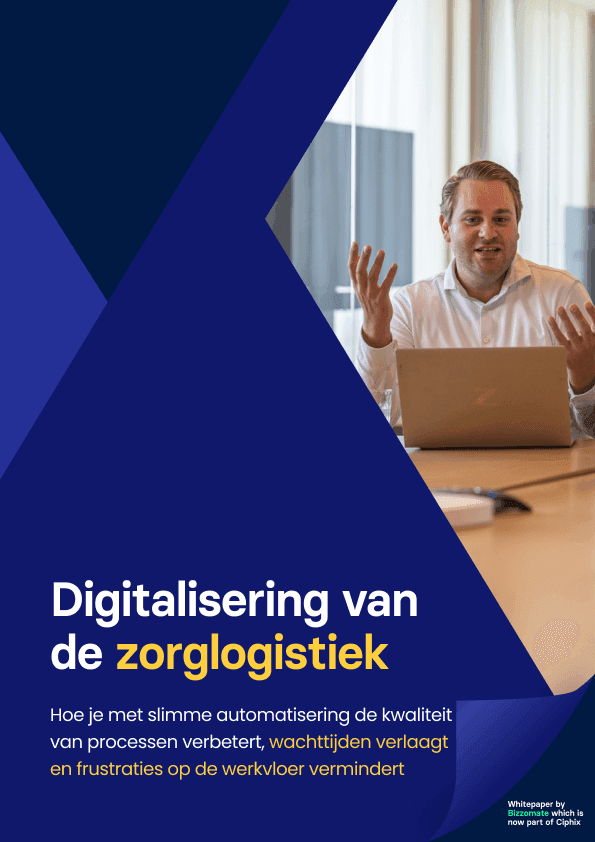Digitising healthcare logistics
Low-code apps provide process support during entire client journey at GGZ inGeest
Reduce administrative pressure with low-code
It has been a pain point for years: mental health care waiting lists. Clients often have to wait months before they can get treatment. This also applies to GGZinGeest. In order to be able to help clients faster and more efficiently, the institution decided to completely digitize the healthcare logistics process surrounding the inflow and outflow of clients with Mendix low-code and Robotic Process Automation (RPA).
- Limited support automation
Many manual operations and error-prone entries in different systems - Meeting Treeknorm
Guidelines of insurers as strategic goal - Digitisation as part of improvement plan
Robotisation and automation of healthcare logistics process important spearhead
Manual and error-prone input work
GGZ inGeest is a medium-sized provider of mental health care in the Amsterdam and Kennemerland region. The institution has several (outpatient) clinics and provides outpatient care to people with mental health problems. It employs about 1800 people, both practitioners and support staff.
Clients who register at one of the GGZ inGeest need to be helped as quickly and properly as possible. Their client information must be entered and their care needs must be interpreted correctly. Then it is important to find the right practitioner and schedule appointments between client and practitioner.
The healthcare logistics process at GGZ inGeest had limited support from automation. This resulted in many manual operations and error-prone entry work in various systems. As a result, it cost staff spend a lot of time emailing and calling to get clients in the right place. Also did not contribute to GGZ inGeest’s desire to meet the Treek standard, a standard set by insurers for waiting times in healthcare.
Digitisation central part of improvement plan
In response to increasing financial and staffing pressures, GGZ inGeest drew up an improvement plan. The goal was to make the organization function more efficiently and reduce waiting times. An important part of this was to digitize the care logistics process surrounding the inflow, throughput and outflow of clients. Robotization and automation were important starting points here.
GGZ inGeest chose UiPath for robotization and Mendix low-code for application development. The chosen solutions are quickly adaptable, making it easy to respond to changing laws and regulations and organizational changes. The institution then went looking for experts who could support them in this regard. After a market survey, they chose Ciphix and Tacstone.
Klaas Nieuwhof, ICT director of GGZ InGeest: “Digitization plays a important role in the extensive improvement project we will be implementing within our institution over the next two years. By investing in back-office applications as an ICT department, we are creating the ideal preconditions to reduce the turnaround time of clients and significantly increase the efficiency of our organization in the coming years. We partnered with the combination of Ciphix and Tacstone Technology because they have the technology, expertise and experience to support this digitization project from start to finish.”
Service design workshops
Ciphix and Tacstone Technology started the digitization process by mapping all systems and tools in the institution. They also analyzed in several service design workshops where the pain points and bottlenecks lay and looked at how they could best support work processes.
Then Ciphix started digitizing the intake process. The first application serves to support the client care process. It secures the care logistics processes and introduces task-oriented work. This gives the institution a clear picture of exactly where the client is in the treatment process.
This is how we work
High involvement of the shop floor
Using the Mendix low-code platform, the first version of the application was able to go live within just three months. The application will initially be used by 150 support staff and in the future by some 850 practitioners.
The support staff is enthusiastic about the first version. Because of Ciphix’s agile approach, they are closely involved in the development. This gives them the opportunity to redesign their work processes and make long-desired improvements around informing referrers and clients.
Moreover, the application already integrates seamlessly with InGeest’s current application landscape, such as e-mail, the electronic client file (ECD) and the General Data Management Code (AGB) registry. Employees can handle referrals from one central environment and collaborate more efficiently and task-oriented across branches. They can also better see through which communication channels they can best be contacted.
RPA vendor Tacstone Technology is engaged in the first phase of automating client enrollment in the ECD. Mark de Poorter, partner at Tacstone Technology: “Automating the enrollment process contributes greatly to reducing the administrative burden of GGZ InGeest employees. Fewer errors are made when enrolling clients and the institution can do more with the same number of staff. This gives them space to focus more on their core task: providing the best mental health care.”
Joppe van Gisbergen, partner at Ciphix: “It takes decisiveness and vision in a traditional environment like healthcare not to choose a ready-made product but a flexible custom solution based on Mendix low-code and RPA. We are very much looking forward to taking up this challenging project together with the GGZ InGeest team. We are convinced that with our knowledge of digitizing and optimizing business processes, we will have a great impact on improving the inflow, throughput and outflow process of clients of GGZ inGeest in the next two years so that they are helped better and faster.”
Nieuwhof adds, “Thanks to Ciphix’s thorough approach in the preliminary phase, we already have a much better idea of how to further optimize our work processes. We have formulated a number of important objectives together, including better information provision for clients and practitioners, getting clients to the right place faster, reducing administrative burdens and cost savings. With Ciphix and Tacstone on board, I am confident that we will eventually fully realize these objectives. We have already made a good start with the digitization of the intake process.”
Making your own appointments in the future
An important part of the follow-up process will be a scheduling application. This will provide better insight into the treatment capacity of the institution and maximize the valuable time of the available practitioners.
By giving them insight into the availability of practitioners, clients can then digitally schedule an appointment with a practitioner at a time that suits them, for example. The Mendix platform is ideally suited to realize these objectives as well.
- Increased staff involvement in digitisation
Agile working method engages staff and increases support - Seamless integration
App works with current application landscape including email, ECD and AGB registry - Centralized environment ensures efficiency
Collaboration, insight and communication between multiple sites better possible
Challenge us!
Looking for a partner who understands your organisation and translates it into digital solutions with results?
Discover
Define
Design
Do




